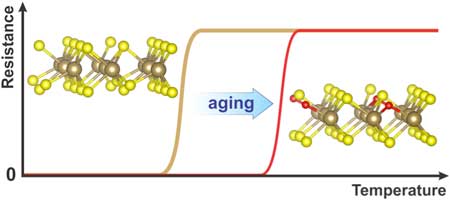| May 08, 2020 | |
Ultrathin superconductor ages like fine wine |
|
| (Nanowerk Spotlight) Superconducting materials, which entirely lose their electrical resistance at low temperatures, have become ever more widespread over recent years. Nevertheless, the fascinating phenomenon of superconductivity does not cease to surprise, as the kinds of materials able to superconduct, as well as the mechanisms through which superconductivity emerges, have become increasingly diverse. Even the temperatures at which superconductivity can arise are rapidly approaching technologically applicable limits, painting a promising future for loss-free, energy-saving electronics. | |
| At the same time, the last decade has witnessed the advent of ultrathin 2D materials, with extraordinary properties, by which they supersede their traditional bulk counterparts in many areas, fostering a multitude of applications. | |
| Among the latest of such properties to be discovered is superconductivity. One of the prime examples is found in the compound 2D material tantalum disulfide (TaS2), where the critical temperature below which superconductivity appears increases multifold as the crystal is made thinner down to a monolayer. | |
| This beautiful find is highly nontrivial to explain. Firstly, the effective repulsion between the electrons is expected to increase in thinner samples, yet the formation of electron-pairs – so-called Cooper-pairs, the carriers of superconductivity – is seemingly facilitated in ultrathin TaS2. | |
| One possible explanation lies in the competition between different phases of the material, where formation of Cooper-pairs gets enhanced by the suppression of its nemesis – a peculiar spatial modification of the electron density called the charge-density wave. | |
 |
|
| Figure: The superconducting state, characterized by completely vanishing electrical resistance, extends to higher temperatures as TaS2 samples age, owing to gradual healing of the crystal lattice by oxygen (red spheres). (Image: University of Antwerp | |
| As the latest breakthrough, a team of researchers from the University of Antwerp (Belgium) and the National Graphene Institute (UK) noticed that the superconducting critical temperature of few-layer TaS2 increases even further if samples are left to 'age' for several weeks (see the figure above). | |
| Quantum-mechanics-based simulations revealed the origin of this increase to likely be oxidation, which is usually detrimental to electronic devices and avoided at all costs. Not only does oxygen favorably heal sulphur vacancies present in freshly made samples of TaS2, it also strongly boosts the electron-phonon interaction responsible for the formation of Cooper-pairs. | |
| Careful experimental tracing of the oxygen content and the corresponding critical temperature of the 'aged' superconductor verified the premise, as now published in Nano Letters ("Enhanced Superconductivity in Few-Layer TaS2 due to Healing by Oxygenation"), a renown journal of nanoscience. As such, 2D flakes of TaS2 acquire improved superconducting properties as they age, akin to how the quality of an excellent red wine further improves as it ages. | |
| "Just like not every wine benefits from aging, not every 2D superconductor will improve with time," says Jonas Bekaert, the first author of the study. "A lot will depend on the kind of defects it contains and what it is exposed to while aging. But our find beats the prevailing thought that a rising amount of imperfections is something purely detrimental. This prompts us to now completely rethink the use of chemical imperfections to ???soften the tannins??? of selected properties in 2D materials." | |
|
Provided by the University of Antwerp as a Nanowerk exclusive
|
|
|
Become a Spotlight guest author! Join our large and growing group of guest contributors. Have you just published a scientific paper or have other exciting developments to share with the nanotechnology community? Here is how to publish on nanowerk.com. |
|
